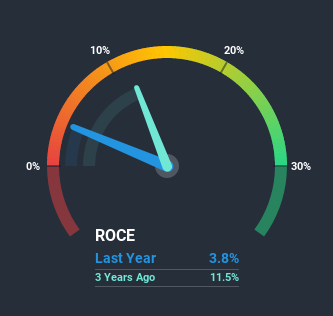What These Trends Mean At Astronics (NASDAQ:ATRO)

When it comes to investing, there are some useful financial metrics that can warn us when a business is potentially in trouble. When we see a declining return on capital employed (ROCE) in conjunction with a declining base of capital employed, that's often how a mature business shows signs of aging. Basically the company is earning less on its investments and it is also reducing its total assets. In light of that, from a first glance at Astronics (NASDAQ:ATRO), we've spotted some signs that it could be struggling, so let's investigate.
Return On Capital Employed (ROCE): What is it?
For those who don't know, ROCE is a measure of a company's yearly pre-tax profit (its return), relative to the capital employed in the business. Analysts use this formula to calculate it for Astronics:
Return on Capital Employed = Earnings Before Interest and Tax (EBIT) ÷ (Total Assets - Current Liabilities)
0.038 = US$21m ÷ (US$659m - US$112m) (Based on the trailing twelve months to June 2020).
Thus, Astronics has an ROCE of 3.8%. Ultimately, that's a low return and it under-performs the Aerospace & Defense industry average of 9.6%.
View our latest analysis for Astronics
Above you can see how the current ROCE for Astronics compares to its prior returns on capital, but there's only so much you can tell from the past. If you'd like, you can check out the forecasts from the analysts covering Astronics here for free.
So How Is Astronics' ROCE Trending?
In terms of Astronics' historical ROCE movements, the trend doesn't inspire confidence. Unfortunately the returns on capital have diminished from the 18% that they were earning five years ago. On top of that, it's worth noting that the amount of capital employed within the business has remained relatively steady. Companies that exhibit these attributes tend to not be shrinking, but they can be mature and facing pressure on their margins from competition. So because these trends aren't typically conducive to creating a multi-bagger, we wouldn't hold our breath on Astronics becoming one if things continue as they have.
The Key Takeaway
In the end, the trend of lower returns on the same amount of capital isn't typically an indication that we're looking at a growth stock. This could explain why the stock has sunk a total of 78% in the last five years. With underlying trends that aren't great in these areas, we'd consider looking elsewhere.
Astronics does come with some risks though, we found 2 warning signs in our investment analysis, and 1 of those shouldn't be ignored...
While Astronics isn't earning the highest return, check out this free list of companies that are earning high returns on equity with solid balance sheets.
This article by Simply Wall St is general in nature. It does not constitute a recommendation to buy or sell any stock, and does not take account of your objectives, or your financial situation. We aim to bring you long-term focused analysis driven by fundamental data. Note that our analysis may not factor in the latest price-sensitive company announcements or qualitative material. Simply Wall St has no position in any stocks mentioned.
Have feedback on this article? Concerned about the content? Get in touch with us directly. Alternatively, email editorial-team@simplywallst.com.

 Yahoo Movies
Yahoo Movies 

